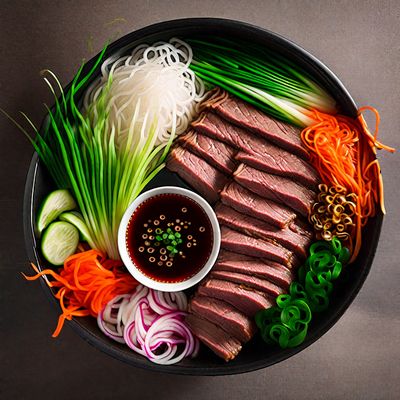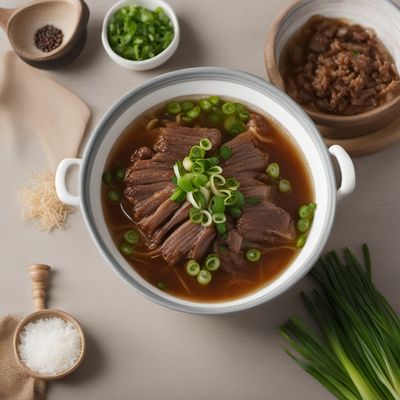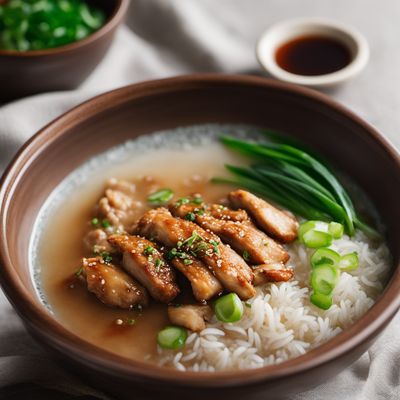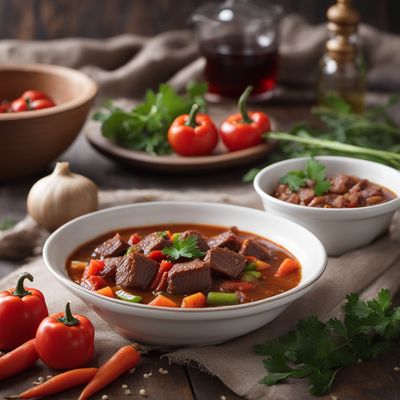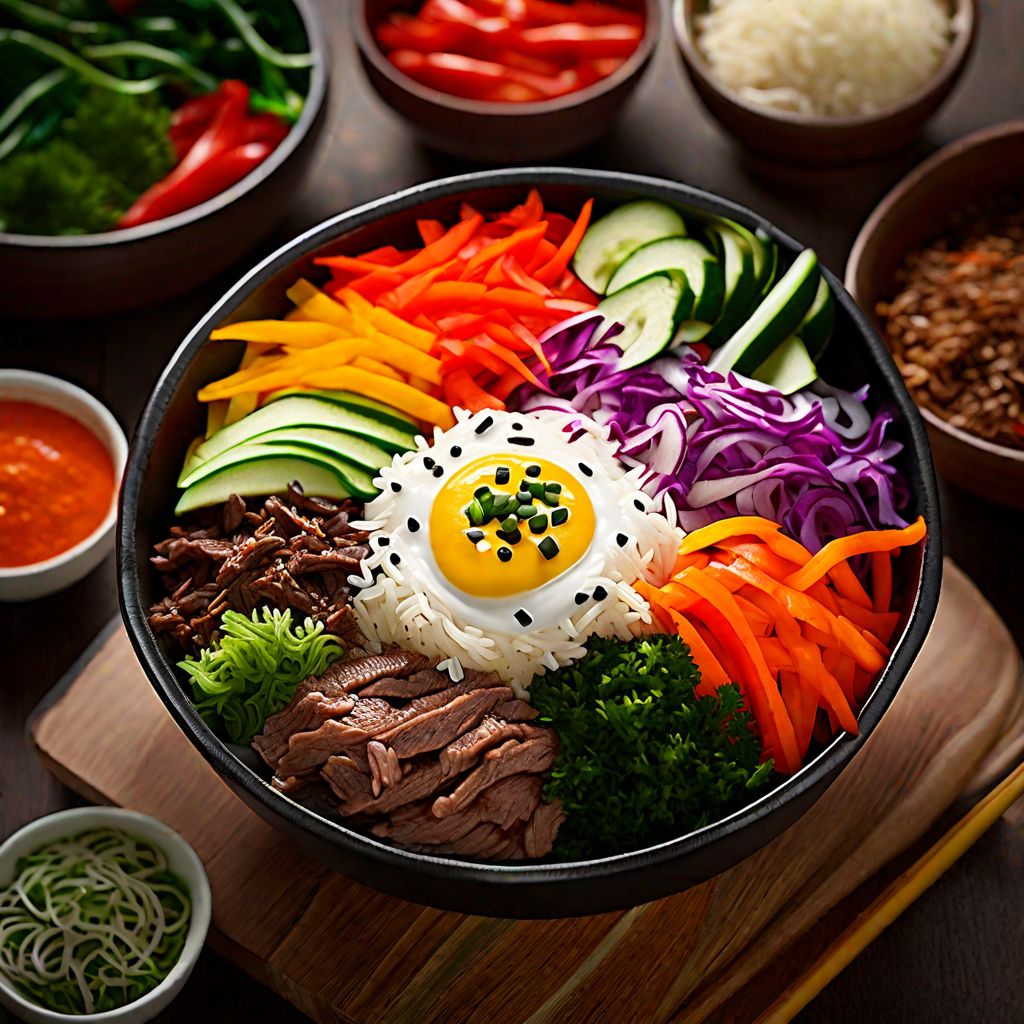
Recipe
Hungarian-style Bibimbap
Goulash-inspired Bibimbap: A Fusion of Korean and Hungarian Flavors
4.8 out of 5
In the context of Hungarian cuisine, this Hungarian-style Bibimbap brings together the vibrant flavors of Korea and the hearty essence of Hungarian goulash. This fusion dish combines the traditional Korean rice bowl with Hungarian ingredients and spices, resulting in a unique and delicious culinary experience.
Metadata
Preparation time
20 minutes
Cooking time
15 minutes
Total time
35 minutes
Yields
4 servings
Preparation difficulty
Easy
Suitable for
Omnivore, Gluten-free, Dairy-free (if sour cream is omitted), Nut-free, Low-carb (if rice is substituted with cauliflower rice)
Allergens
N/A
Not suitable for
Vegan, Vegetarian, Paleo, Keto, Pescatarian
Ingredients
While the original Korean Bibimbap typically includes ingredients like gochujang (Korean chili paste) and kimchi, this Hungarian adaptation incorporates Hungarian paprika and goulash flavors. The traditional Korean vegetables are replaced with Hungarian vegetables like bell peppers, carrots, and cabbage. The dish is also served with a dollop of sour cream, a staple in Hungarian cuisine. We alse have the original recipe for Bibimbap, so you can check it out.
-
2 cups (470ml) cooked rice 2 cups (470ml) cooked rice
-
1 tablespoon vegetable oil 1 tablespoon vegetable oil
-
1 onion, thinly sliced 1 onion, thinly sliced
-
2 cloves garlic, minced 2 cloves garlic, minced
-
1 red bell pepper, thinly sliced 1 red bell pepper, thinly sliced
-
1 carrot, julienned 1 carrot, julienned
-
1 cup (150g) shredded cabbage 1 cup (150g) shredded cabbage
-
200g beef, thinly sliced 200g beef, thinly sliced
-
1 tablespoon Hungarian paprika 1 tablespoon Hungarian paprika
-
1 teaspoon caraway seeds 1 teaspoon caraway seeds
-
Salt and pepper, to taste Salt and pepper, to taste
-
4 tablespoons sour cream 4 tablespoons sour cream
-
Fresh parsley, for garnish Fresh parsley, for garnish
Nutrition
- Calories (kcal / KJ): 350 kcal / 1465 KJ
- Fat (total, saturated): 12g, 4g
- Carbohydrates (total, sugars): 40g, 6g
- Protein: 20g
- Fiber: 5g
- Salt: 1g
Preparation
-
1.Heat the vegetable oil in a large skillet over medium heat. Add the sliced onion and minced garlic, and sauté until the onion becomes translucent.
-
2.Add the sliced bell pepper, julienned carrot, and shredded cabbage to the skillet. Cook for 5 minutes, or until the vegetables are slightly tender.
-
3.Push the vegetables to one side of the skillet and add the thinly sliced beef to the other side. Cook the beef until it is browned and cooked through.
-
4.Sprinkle Hungarian paprika, caraway seeds, salt, and pepper over the vegetables and beef. Stir everything together to evenly coat the ingredients with the spices.
-
5.Divide the cooked rice among serving bowls. Top each bowl with the vegetable and beef mixture.
-
6.Garnish each bowl with a dollop of sour cream and fresh parsley.
Treat your ingredients with care...
- Beef — For a tender and flavorful result, thinly slice the beef against the grain.
- Hungarian paprika — Use high-quality Hungarian paprika for an authentic and robust flavor.
- Sour cream — Opt for full-fat sour cream to add richness to the dish.
Tips & Tricks
- To add an extra kick of flavor, sprinkle some smoked paprika over the dish before serving.
- Feel free to customize the vegetable selection based on seasonal availability and personal preference.
- For a vegetarian version, substitute the beef with tofu or tempeh.
- Experiment with different toppings such as pickled cucumbers or fried eggs to enhance the dish.
- If you prefer a spicier Bibimbap, add a dash of Hungarian hot paprika or chili flakes.
Serving advice
Serve the Hungarian-style Bibimbap hot, allowing the flavors to meld together. Mix all the ingredients well before enjoying to ensure each bite is bursting with deliciousness.
Presentation advice
For an appealing presentation, arrange the colorful vegetables and beef on top of the rice in an organized manner. Place a dollop of sour cream in the center and garnish with fresh parsley for a pop of green.
More recipes...
For Bibimbap » Browse all
For Korean cuisine » Browse all
More Korean cuisine dishes » Browse all

Gamjasaelleodeu
Potato salad
Gamjasaelleodeu is a Korean dish made with potatoes and beef.
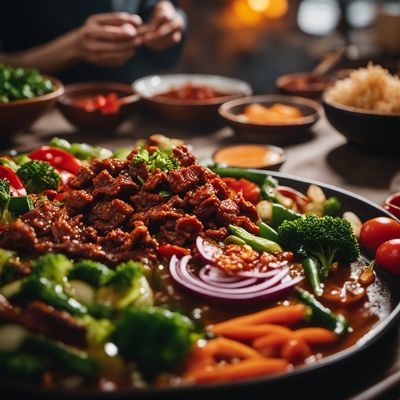
Gochujang bokkeum
Spicy Stir-Fried Meat and Vegetables
Gochujang bokkeum, also known as stir-fried spicy pork, is a Korean dish. It is made with pork, vegetables, and a spicy sauce made with gochujang.

Naengguk
Cold soup with beef and vegetables
Naengguk is a Korean cold soup that is perfect for hot summer days.
More Hungarian cuisine dishes » Browse all

Lekváros bukta
Lekváros bukta is a traditional Hungarian pastry that is filled with fruit preserves. It is a popular dessert that is often served with coffee or tea.

Lángos
Langos
Lángos is a popular Hungarian street food that is made by deep-frying a dough made from flour, yeast, and milk. It is a crispy and savory snack...

Tepertős pogácsa
Tepertős pogácsa is a traditional Hungarian pastry that is made with pork cracklings and a savory dough. It is a delicious and hearty snack that...





